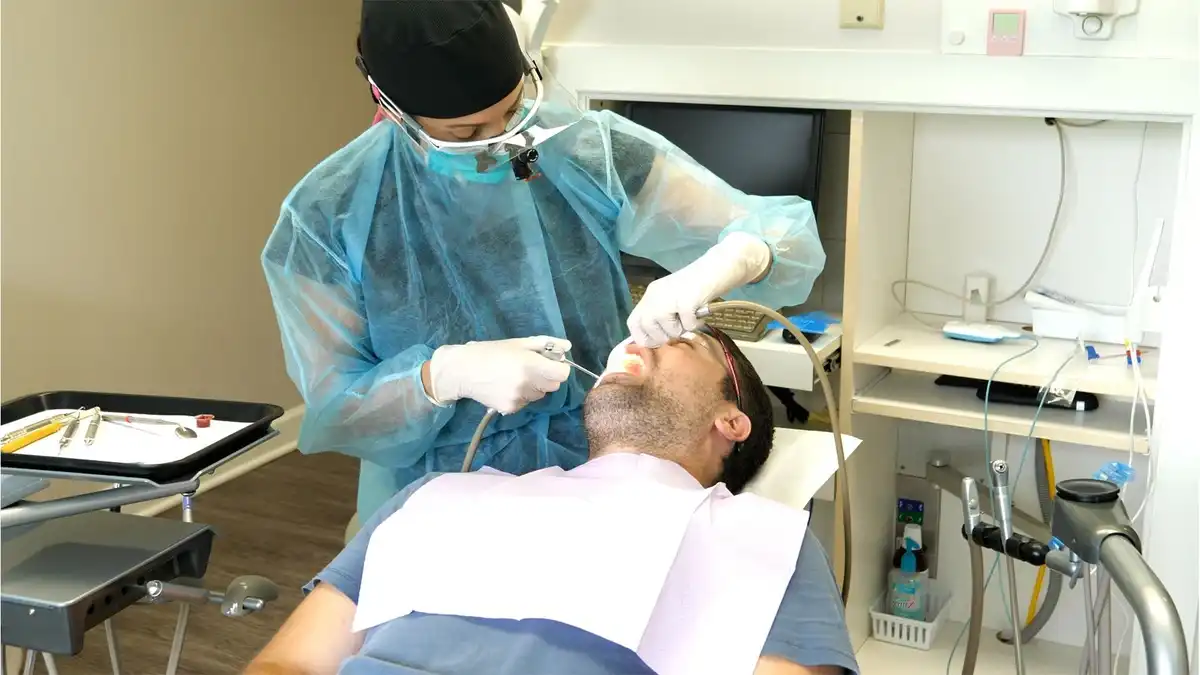How Much Is A Deep Cleaning At The Dentist?


A scaling and root planing (sometimes called an SRP, SCRP, or deep cleaning) is a special type of dental cleaning designed for people with active periodontal disease. Unfortunately, unlike preventative dental cleanings you usually book every six months, deep cleanings aren’t covered at 100% by your dental insurance. An SRP cleaning cost can make some people not want to schedule it at all. But don’t let deep cleaning cost deter you, because the longer you wait to address your gum infection, the more damage you’ll do to your mouth. How much does a deep cleaning cost? It depends on how many teeth are involved and what your insurance coverage is like. You can also save big by being prepared and save up to 60% on deep cleanings with a dental savings plan.
Do I Need A Deep Cleaning?
The easiest explanation of why you might need a deep cleaning is to understand what a normal cleaning doesn’t do. A normal preventative cleaning is meant for maintenance purposes, to keep your mouth healthy. It doesn’t reach far down under the gums in deep “pockets” where active disease and heavy tartar buildup exist. If you were to skim over those areas, it would essentially be “supervised neglect” on the part of your dentist and hygienist. So, if you do have evidence of disease in your mouth, your dentist and hygienist will tell you that you need an SRP or “deep cleaning” to restore your smile to a disease-free state.
You’ll know you need a deep cleaning if you have symptoms of:
- Periodontal (gum) pockets of 5mm or deeper
- Heavy tartar buildup across the roots of your teeth
- Swollen, bleeding gums
- Tooth mobility
- Halitosis
- Bone loss
Cost Factors Influencing SRP Fees
Unlike a preventative dental cleaning, deep cleaning cost is dependent upon a few different factors at play. Depending on which ones relate to your unique situation, it will cause the cost of an SRP to go up or down. Some of the most common variables are:
1) How many quadrants of your mouth are being cleaned
Deep cleanings are usually divided up by fourths, with one-fourth of your mouth being cleaned at a time. Most people with gum disease need all four quadrants of their mouth to be cleaned.
2) The number of teeth in each quadrant
Someone without their wisdom teeth will have seven teeth per quadrant. But maybe you’ve experienced tooth loss or only have a few teeth with active periodontal disease. Deep cleaning cost can be adjusted depending on the number of teeth involved per quadrant. Typically, it’s “four or more” or fewer than four.
3) How many visits there are in total
The total number of appointments will impact the overall out of pocket costs incurred. Especially if sedation or add-on anesthetics are involved.
4) If you request sedation (laughing gas) during the visit
Some people prefer a light sedative during their dental cleanings. Usually, this step is completely optional and left up to the preferences of the individual patient. But sedation does come at an added cost, especially if it’s deeper types of medications that are being used. Nitrous oxide tends to be the most affordable option and may only cost an additional $20-40 at each appointment.
5) Whether a debridement is needed beforehand
Before a deep cleaning can be administered, your insurance company will need a completely thorough periodontal chart and full mouth series of X-rays to show that you’re in need of an SRP. But if there’s so much buildup that your dentist can’t actually see your gums to measure them, you may need a “debridement” first. This isn’t an actual cleaning; it’s just a quick removal of heavy tartar deposits so that you can receive an accurate examination to plan the best course of treatment.
6) Your post-periodontal maintenance
Technically speaking, periodontal disease doesn’t reverse itself and you’ll always have some gum and bone loss. Your recurring dental cleanings will probably be a periodontal maintenance visit, rather than a preventative cleaning (prophylaxis.) This slight difference must be coded differently on your dental insurance claims, which will also impact your long-term out-of-pocket costs.
What Is SRP Cost Without Insurance?
How much does a deep cleaning cost without insurance?
Per Quadrant: $300
Full Mouth: $800 to $1,800
Depending on what part of the country you live in, it averages about $300 per quadrant if you still have all of your teeth. That price can fluctuate by $100-$150 or so per quadrant. Overall, without insurance, you’re looking at an average of anywhere from $800-1800 for your full mouth (if you have all of your teeth.)
The price is lower for quadrants with fewer than four teeth. In that case, you’re looking at about $100 less on average per quadrant. So around $200 per quadrant or $600-1200 for your full mouth if there are fewer than four teeth in each quadrant.
You can save up to 60% on deep cleanings with a dental savings plan.
How Much Is A Deep Cleaning With Insurance?
How much does a deep cleaning cost if you’re using dental insurance coverage?
Per Quadrant: $150 to $200
Full Mouth: $400 or $900
Unlike normal preventative cleanings—which are usually covered at 100%—deep cleaning cost is only partially covered by dental insurance. Since insurance is usually prevention-based, it pays more for preventative services. If you have gum disease, you’re no longer preventing dental infections, but treating them.
Every dental insurance policy is different. Usually, the specifics are worked out by your employer or yourself, before buying into the plan. On average, the usual dental insurance policy will cover deep cleanings at about 50%. That’s far less than the 100% most people are used to for their dental cleanings. This scenario can lead to a bit of sticker shock, especially if you’re not used to paying $400 or $900 to have all of your teeth cleaned. Just remember that it’s a treatment consisting of soft tissue therapies; it’s not a maintenance or preventative cleaning.
Neglecting to go to the dentist for your regular checkups can cost you big time, especially if you develop gum disease. But paying for an SRP with insurance will still save you money—and your teeth—throughout your smile’s lifetime. Don’t put it off.
You can save up to 60% on deep cleanings with a dental savings plan.
What Are The Risks Of Not Getting An SRP?
Hands down, the most common reason why people don’t follow through with their deep cleaning is related to SRP cleaning cost. They might ask for “just a normal cleaning” that’s covered by insurance or try to call around and find an office that will.
If you don’t get a deep cleaning when you have active gum disease, the bacteria under your gums will continue to proliferate. In time, the tissues and bone around the roots of your teeth will detach and dissolve, causing your teeth to become mobile and eventually fall out. It’s not a matter of “if” but “when.” The longer you wait to get a deep cleaning, the greater the risk there is of not ever being able to get the gum infection under control.
- Heart disease, including high blood pressure, stroke, and heart attack
- Diabetes
- Infertility in both men and women
- Erectile dysfunction
- Preeclampsia and preterm labor
- Pneumonia
The good news is that once you eliminate the infection inside of your mouth, your immune system is boosted and your body can better recover from these underlying medical conditions.
What’s The Cheapest Way To Get An SRP?
If you can’t afford the deep cleaning cost with or without insurance, here are two great options to consider:
Dental Hygiene Schools
Do you live near a dental or dental hygiene school? Your state dental board will list accredited programs in your area. Dental hygiene schools always need patients, especially ones with active periodontal disease. Hygiene students actually need to complete a specific number of deep cleanings to graduate and they are closely monitored by dentists and seasoned Registered Dental Hygienists. Depending on the school, you may pay as little as $0 or $20 for your deep cleaning. The tradeoff is that you’re there for a little extra time for treatment planning and follow-up to show comprehensive care on the part of the hygiene student.
Dental Savings Plans
Dental discount plans are great for families or individuals that are looking to save 10% to 60% on the average cost of dental care. Dental plans are nationwide with over 100,000 dentists in the program, see if you can save with a dentist near you.
Payment Plans
You can easily finance your deep cleaning with an in-house or third-party dental payment plan. Most offices partner with patient platforms that offer 0% or low-interest financing for 6-12 months or more. You can usually make low monthly installments on your deep cleaning and completely pay it off before any interest charges begin to kick in.
What To Expect From An SRP
Not everyone wants their mouth to be numb, but it’s always an option. Some people prefer more of a short-term numbing gel or rinse to desensitize their teeth and gums. The advantage of using local anesthetic is that your hygienist can clean half of your mouth without the other side being numb.
Your deep cleaning will almost certainly be broken up into at least two visits, with one half of your mouth being cleaned at one and the other half at the next.
Do SRP Cleanings Hurt?
Most people with gum disease have sensitive teeth and gum tissues. Hence why deep cleanings are usually performed with local anesthetic. But the tooth sensitivity shouldn’t be so much that you need to be “knocked out” for the visit. Some people do request nitrous oxide (laughing gas) to help them relax a little more.
Don’t Let Deep Cleaning Cost Deter You
Your smile is forever. If SRP cleaning cost is the only thing standing in the way of you and a healthier mouth, be sure to explore financing options, dental schools, or talk to your dentist. Your mouth isn’t the only thing at risk; your body depends on a healthy oral environment to keep your immune system going. The modest investment in a deep cleaning will pay off for decades to come.

Make your inbox smile!
Subscribe






